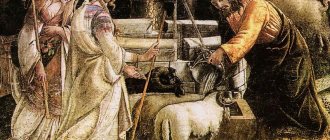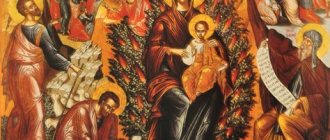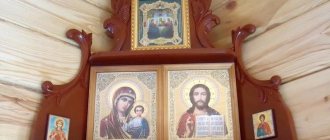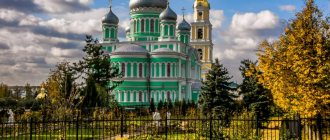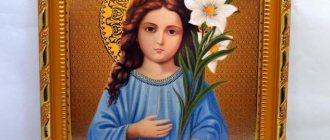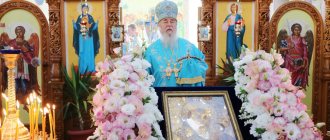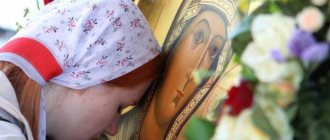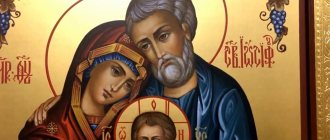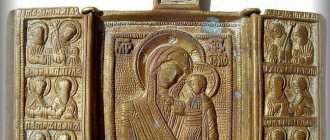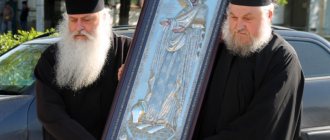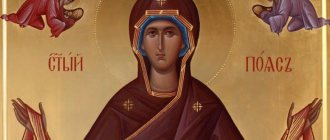Most of the images of the Mother of God that can be seen in Orthodox churches and home iconostases have a fairly laconic plot: the baby (or boy) Jesus sits on the lap of the Queen of Heaven - only the details differ.
However, there are icons of the Mother of God that have a much more complex and symbolic plot. One of them is called the “Burning Bush” icon of the Most Holy Theotokos. This image has complex iconography and many layers of meaning, the interpretation of which is impossible without knowledge of the Old Testament and the foundations of theology. Nevertheless, we will try to tell you about this amazing icon without resorting to complex theological calculations and specific terminology.
A little background
The history of the burning icon of the Mother of God is closely connected with the text from the Old Testament concerning the life and deeds of the prophet Moses.
“The Burning Bush” is the most popular icon against fire in the house. But if you take a closer look at its history, a much deeper meaning and meaning of this image is revealed.
Moses was born in Egyptian lands around the 8th century BC. The Jewish population of Egypt then increased greatly, and the pharaoh, concerned about this, ordered all adult Israelis to be enslaved, and newborn boys to simply be killed.
Moses' mother did not wish such a sad fate for her own son. She first hid the newborn, and then put him in a basket and sent him down the Nile. And it had to happen that he was found by an Egyptian princess who had mercy on the baby!
Ironically, they decided to give Moses to a Jewish family, and it turned out that his own mother became his wet nurse. But he grew up at the court of Pharaoh, surrounded by honors and wealth, like a well-born Egyptian.
But one day Moses saw something terrible: the overseer was mercilessly mocking the working Jews. He became angry, killed the overseer and was forced to flee.
The Jewish husband wandered in the desert for a long time until a priest took him in. Moses began to lead the life of a simple person, got used to physical labor and even married one of the daughters of his savior.
One day the future prophet was tending sheep. Suddenly he saw a burning thorn bush (that is, a “bush”) on Mount Sinai and wanted to approach it, because the bush was burning, but it did not burn up. The miracles did not end there: the Voice of God came from the bush, ordering Moses to take off his shoes, for he intended to approach the shrine. The Lord also commanded the prophet to lead the Jews from Egypt to the Promised Land and endowed him with the ability to perform miracles according to God’s will.
Horace William Petherick. Exodus
According to the Old Testament, Moses led the Jews through the desert for 40 long years. The people of Israel nevertheless reached it, but the prophet died a little short of reaching the goal. According to biblical texts, he lived for 120 years!
Over time, the image of the burning bush became associated with the Mother of God. Just as a bush does not burn in a raging flame, so the Ever-Virgin is eternally pure and immaculate.
History of the icon
The first known images of the “Burning Bush” type appeared at the beginning of our era. The earliest image that has survived to this day is an illustration for the manuscript of the Byzantine Cosmas Indikoplov, now carefully preserved in the Vatican.
It is noteworthy that the original image was more plot-based and simpler to perceive: the Mother of God (usually Oranta), ascending above a burning bush, Moses bowed in reverence. But by the 16th century, the icon acquired a different, much more complex appearance, theological symbolism and many layers of meaning.
In one of the churches of the Chora Monastery in Istanbul, there is a well-preserved fresco depicting the Virgin Mary in a burning bush. And this despite the fact that this temple was a mosque for many centuries!
The first “Burning Bush” came to Rus', most likely, from the East, sometime in the 14th century. It quickly gained popularity because of its “fire-fighting” effect: the houses of our ancestors were wooden and often suffered from fires. Sometimes entire cities burned out!
The “Burning Bush” gained popularity, first of all, among ordinary people: it was present in almost every home iconostasis. People didn’t really understand the numerous layers of meaning – the main thing was that the image protected it from fires. And he sometimes performed true miracles!
This icon was further popularized with the invention of chromolithography. Colorful tin icons from Jacob Jacot were inexpensive, but they were amazingly durable and “elegant” - in a word, an ideal option for the common man.
And now the “Burning Bush” can often be seen in village houses. Moreover, it is often hung not in the “red corner”, but directly above the front door, to protect the home from all troubles.
Chromolithograph of the Burning Bush
Where is the icon of the Burning Bush located?
In Russia there are many revered icons of the “Burning Bush”, some are revered as miraculous.
The oldest icon, brought to Rus' by Palestinian monks from the East in the 14th century, now resides in the Annunciation Cathedral in Moscow. History has not preserved the details of its discovery, but Orthodox sources claim that it was written on the sacred place where Moses saw the burning bush. There are copies of this miraculous image in many Russian churches.
In addition to the above, in Moscow there were two especially revered images of the described type - both in the temple of the same name. The first of them became especially famous in 1812. A Polish soldier, seduced by the rich setting of the image, stole it from the temple. But the thief began to be tormented by attacks of melancholy, and he repentantly returned the stolen goods to the church.
In Moscow (more precisely, in Otradnoye) there is one of the few temples of the “Burning Bush”. This is a remake from 2010. The historical temple of the same name in Khamovniki was demolished in 1930.
The second image from the temple in Khamovniki (small, supplemented by the image of a praying man) has been venerated since 1837. Attached to it was a handwritten prayer service, which was read during severe thunderstorms. It was believed that this icon was capable of deflecting lightning.
Unfortunately, both of these miraculous images perished in the fire of the revolution and subsequent turbulent years, along with the temple. This is the irony of fate: years of godlessness are destructive even for the shrines that are called upon to protect and preserve.
Temple of the Icon of the Mother of God "Burning Bush" in Khamovniki
Meaning and image of Saint
Since ancient times, people have come to the Queen of Heaven, prayed and asked her for help, she helped in resolving various difficult life situations. Considering the long history of the Burning Bush icon, its significance is very great in the Orthodox world, we can say with confidence that it helps in many different situations:
About the author About the book
- in ancient times, during wars, commanders often asked for help from this icon to protect their soldiers in battle;
- The face of Our Lady protects firefighters, doctors, pilots, and military personnel. The icon protects believers from burns, rash actions, injuries and other things;
- Orthodox Christians often believe that the Burning Bush can deliver from committed sins;
- the image of the Mother of God is often used as a talisman for one’s home from all sorts of misfortunes;
- People suffering from mental illnesses often ask this icon for help in order to get rid of them.
The meaning of this icon lies entirely in its iconography. This image of the Mother of God sums up the idea of the Mother of God-Church-Sophia.
The meaning of the image in Orthodoxy
The significance of the Burning Bush icon in the home of a true adherent of the Orthodox religion is difficult to overestimate. The actual face of the Mother of God, combined with ambiguous religious symbolism, personifies the image of the Protectress of all Orthodox Christians. And if we remember that the Ever-Virgin is revered as the protector of All Rus' and its inhabitants, the nation’s love for this image becomes understandable.
“The Burning Bush” is a recognized icon of firefighters and everyone whose professional activities and lifestyle are connected with fire. But, according to theological canons, its meaning is much broader. It is called upon to protect each of us not only from external enemies and natural disasters, but also from ourselves, that is, from our own sinful thoughts and deeds.
“The Burning Bush” is a reference to the infallibility of Mary, who remained virgin after the conception of Christ by the Holy Spirit. She reminds us that we must strive to maintain moral purity in this sinful world, but not a single person can compare with the Mother of God in holiness.
Iconography
There are two iconographic types of the “Burning Bush” revered by Orthodox Christians.
The first type can be classified as archaic, directly referring to Old Testament events. Now you rarely see it anywhere: many icons of this version were destroyed during the struggle against the Old Believers, to which Patriarch Nikon had a heavy hand.
In the center of the composition of such icons is a bush engulfed in flames and the Mother of God soaring above it. Below is an image of Moses (either tending sheep or taking off his shoes before entering the holy land). Angels and spirits may be present, but are not required.
The later image is much more symbolic and polysemantic: only theologians can correctly interpret the numerous layers of meaning. It often lacks even the notorious burning bush - its image is replaced by symbolism.
In the center of the composition is the Virgin Mary with the little Savior on her knees (in one of the canonical versions, usually Oranta or Panahrant). She is depicted against the background of an octagon (eight-pointed star) formed by two stylized rhombuses.
The first diamond, blue or dark green, symbolizes the purity of the Virgin Mary. The second, bright red, means the flame of a burning bush. In the hands of the Mother of God they often depict a ladder leading humanity to the Kingdom of Heaven.
On the left is an archaic type of icon, on the right is a later image.
The overlapping of diamonds forms an eight-pointed figure. Among other things, this is a reference to the Star of Bethlehem, which shone in the heavens with the birth of Christ. Thanks to her, the Magi found their way to the Son of God.
The Mother of God is surrounded by a mass of other images, each of which carries a certain meaning. Their composition and location may vary.
As a rule, the icon depicts three spirits, apostle-evangelists (often in a symbolic representation), as well as archangels with canonical attributes. Sometimes the icon also contains scenes from the Old Testament, including the already described historical meeting of Moses with the burning bush.
Days of celebration
The main day of celebration of the icon falls on September 17 (September 4, old style). It is celebrated on the day of remembrance of the prophet Moses, thanks to whom the corresponding Old Testament history arose.
There is one more holiday, although it is a moving one. It is celebrated in the sixth week after Easter. According to some sources, it was on this day that the icon was transferred from the Faceted Chamber to Khamovniki, to the temple of the same name.
Description
This icon depicts the Mother of God through one of Her Old Testament prototypes - the burning bush, i.e. the unburnt bush in which God appeared to Moses. The burning but unburning bush signified the immaculate conception of the Mother of God of Christ from the Holy Spirit, during which She, having become the Mother, remained a Virgin. There is also another reading of the prototype: the Mother of God, having been born into a world of sinful people, remained uninvolved in sin.
The later, symbolic-allegorical image of the Mother of God “The Burning Bush” is now more often encountered. On the icon you can see an octagonal star surrounding a half-length image of the Mother of God and the Child Christ. The star is composed of two sharp quadrangles with concave edges, one of which is painted red - an image of a flame, the other, reminiscent of the greenery of a mysterious bush, is painted green. In the corners of the icon there are four symbols of the Evangelists, as well as archangels with those symbols that church tradition prescribes for them - Michael with a rod, Raphael with an alabaster vessel, Uriel with a fiery sword, Selafiel with a censer, Barachiel with a bunch of grapes and Gabriel with a branch of the gospel . Sometimes a ladder is depicted in the hands of the Most Pure Virgin, touching the shoulder of the Mother of God - a sign that She raised humanity from earth to Heaven. Sometimes they also write the gates and the rod - a symbol of the Savior, called in church songs “the rod from the root of Jesse.” The fields of the icon are filled with heavenly powers and angels of the elements praising the Mother of God and worshiping Her - dew, thunder, darkness, frost, ice, fire, etc.
| Burning Bush, icon of the Mother of God |
The more ancient form of the icon of the Mother of God “The Burning Bush” is more literal - it depicts a bush engulfed in flames, above which the Mother of God rises with the Child of God in her arms or with raised hands - in the pose of Oranta or the Sign. The prophet Moses is depicted kneeling in front of a bush.
What does “Burning Bush” help with?
As mentioned above, the icon protects, first of all, from fires and lightning. But her power does not end there, because before us is the image of the Most Pure Virgin, that is, the eternal Intercessor of all humanity.
The emblem of the Russian Ministry of Emergency Situations contains a white eight-pointed star. This is a reference not only to the Star of Bethlehem, but also to the recognizable symbolism of the “Burning Bush”.
They pray to the “Burning Bush” for:
- rescue from natural disasters;
- humility of anger (both one’s own and directed at the person praying);
- healing from physical and mental illnesses;
- getting rid of “love fever” and returning spouses to their families;
- salvation of the soul and deliverance from sinful thoughts.
Miracles associated with the icon
In Russia, the most famous miracle is the one that led to the establishment of the Church of the Burning Bush icon in Khamovniki in the 17th century.
Boyar Dmitry Koloshin, stirrup of Tsar Feodor, loved to pray to the “Burning Bush” icon, hung in those years in the Faceted Chamber of the Kremlin. Somehow envious people slandered the boyar, and the royal wrath fell on the eager one. In fear, Dmitry Koloshin turned to his favorite image for help. The Heavenly Intercessor appeared to the monarch in a dream, and he had mercy on the innocently slandered stirrup.
In gratitude and in memory of the miracle revealed, Koloshin founded the Church of the Burning Bush Icon of the Mother of God in Khamovniki. The icon, recognized as miraculous, was also transferred there.
Another miraculous icon is located in a small temple in the village of Suksun, Perm Territory. There she appeared in the 17th century in a completely inexplicable way. It was discovered by a local fisherman: he saw the icon floating along the river.
The fisherman was a Muslim, so he decided not to touch the Christian image, but the next day the icon sailed to him again. The man saw God’s intention in this and took the image to the temple. There the icon was hung in its proper place, a prayer service was served, and it began to work miracles.
In Ulyanovsk there is also a temple of the Burning Bush icon. The image of the Mother of God was brought there from Athos a little over a century ago, and almost immediately it began to perform miracles of healing. They say that even people far from Christianity received help from him.
Icon "Burning Bush" in Ulyanovsk
Another image known for miracles is located in the city of Slavyansk, in the Donetsk region, in Ukraine. Its appearance is associated with a series of fires that gradually destroyed the city in 1822. He would have burned out, but a vision revealed to the parishioner Belnitskaya helped him overcome his misfortune.
The Ever-Virgin visited the townswoman in a dream and ordered her to create the image of the “Burning Bush.” Belnitskaya shared this with the archpriest, the icon was painted, and a prayer service was served before it. And soon the arsonist was discovered, who turned out to be the girl Mavra, a local madwoman.
Find out who is your Guardian Angel and Intercessor Icon
1:502 1:507
It turns out that each of us has our own Guardian Angel and our own intercessor icon, which is given from birth. If you don’t yet know who protects and protects you, then our article is for you!
1:837 1:842
will be protected by the “Sovereign” icon of the Mother of God, and their guardian angels are Saint Sylvester and Venerable Seraphim of Sarov.
1:1141 1:1146 1:1217
2:1721 2:4
I stand before Your Sovereign Icon, embraced in prayerful awe, and Your royal Face, crowned with a crown, attracts my tender gaze to Itself. In a time of turmoil and inglorious cowardice, Betrayal, lies, unbelief and evil, You showed us Your Sovereign Image, You came to us and meekly prophesied: “I myself took the scepter and the orb, I myself will hand them over to the Tsar again, I will give greatness to the Russian kingdom and glory, I will nourish, console, and reconcile everyone.” Repent, Rus', unfortunate harlot... Wash your desecrated shame in tears, Your Intercessor, the Heavenly Queen, pities and protects you, a sinner.
2:1045
S. Bekhteev
2:1066 2:1071 2:1140
3:1644 3:4
Before the icon of the Most Holy Theotokos “Sovereign” they pray for truth, heartfelt joy, unfeigned love for each other, for peace in the country, for the salvation and preservation of Russia, for the protection of the throne and the state, for deliverance from foreigners and for the granting of healings of body and soul.
3:515 3:520 4:1024
are guarded by Saints Athanasius and Cyril, and will be protected by the icons of the Mother of God “Vladimir” and “Burning Bush”.
4:1296 4:1301
The “Vladimir” Icon of the Mother of God has been revered as miraculous for several centuries. Before her, they prayerfully ask the Mother of God for healing from bodily ailments, in particular, diseases of the heart and cardiovascular system. People turn to her for help during disasters, when they need protection from enemies. In front of the Vladimir Icon of the Mother of God in all centuries they prayed for the preservation of Russia. Every home should have this icon, because it reconciles those at war, softens people’s hearts, and helps strengthen faith.
4:2242 4:4 4:81
5:585
The Vladimir Icon of the Mother of God was written by the Evangelist Luke on a board from the table at which the Savior dined with the Most Pure Mother and Righteous Joseph. The Mother of God, seeing this image, said: “From now on, all generations will bless Me. May the grace of the One born of Me and Mine be with this icon.” In 1131, the icon was sent to Rus' from Constantinople to the holy prince Mstislav († 1132, commemorated April 15) and was placed in the Maiden Monastery of Vyshgorod - the ancient appanage city of the holy Equal-to-the-Apostles Grand Duchess Olga .
5:1532 5:4 5:64
6:568 6:573
Before the icon of the Most Holy Theotokos “The Burning Bush” they pray for deliverance from fire and lightning, from severe troubles, and for the healing of ailments.
6:836 6:841
The icon of the Mother of God “The Burning Bush” is depicted in the form of an octagonal star, consisting of two sharp quadrangles with concave ends. One of them is red, reminiscent of the fire that surrounded the bush seen by Moses; the other is green, indicating the natural color of the bush, which it retained when engulfed in fiery flames. In the middle of the octagonal star, as if in a bush, the Most Pure Virgin with the Eternal Child is depicted. At the corners of the red quadrangle there are depicted a man, a lion, a calf and an eagle, symbolizing the four evangelists.
6:1885 6:4
In the hands of the Most Pure Virgin is a ladder, leaning its upper end against Her shoulder. The ladder means that through the Mother of God the Son of God descended to earth, raising to Heaven all who believe in Him.
6:334 6:339
It happened: the gray-haired church of the Burning Bush, crouching in a white snowstorm, blinks at me from the silence; In front of the thoughtful icon case - an unquenchable lantern; And a pink snowball falls in a light flight Under the light. Neopalimov Lane is boiling with pearl barley blizzard; And the Mother of God looks into the alley with a thoughtful tear.
6:862 6:867 7:1371
the intercessor is the icon of the Iveron Mother of God.
7:1553
Their guardian angels are Saints Alexius and Milentius of Antioch.
7:115
The history of the Iveron Icon can be traced back to the first century, when, out of indescribable love for people, the Mother of God blessed the holy Apostle and Evangelist Luke to paint its image during the days of Her earthly life.
7:501
The Monk John of Damascus wrote: “The Holy Apostle and Evangelist Luke, at a time when the Most Holy Mother of God still lived in Jerusalem and dwelt in Zion, painted Her Divine and honest image on a board with picturesque means, so that, as in a mirror, subsequent generations would contemplate her and childbirth.
7:1027 7:1032
When Luke presented this image to Her, She said: “From now on all generations will bless Me. May the grace and power of the One born of Me and Mine be with you.” and Tradition attributes to the brushes of the holy Apostle and Evangelist Luke from three to seventy icons of the Mother of God, including the Iveron icon.
7:1532 7:4 7:74
8:580 8:585
Before the Iveron Icon of the Most Holy Theotokos they pray for deliverance from various misfortunes and for consolation in troubles, from fire, for increasing the fertility of the earth, for deliverance from grief and sadness, for the healing of physical and mental ailments, in difficult circumstances, for help to farmers
8:1095 8:1100 9:1604
one must ask for protection from the icon of the Kazan Mother of God, and they are protected by saints Sophrony and Innocent of Irkutsk, as well as George the Confessor.
9:317 9:322
We do not know by whom and when the icon of the Russian Mother of God Hodegetria was painted, which translated from Greek means “Guide”. The image of the Kazan Mother of God belongs to this type of icon.
9:687
An ancient Russian monk-icon painter, inspired by the image of the Byzantine Hodegetria, which is believed to have been painted by the Evangelist Luke during the life of the Mother of God, paints his own version of this icon. Its iconography, compared to the Byzantine one, is slightly changed. The Russian version can always be recognized by its barely noticeable warmth, softening the regal severity of the Byzantine originals.
9:1366 9:1371 9:1442
10:1946 10:4
The Kazan Mother of God and her holy, miraculous, saving icon (she returns sight to the blind, gives strength to the weak) are considered practically official intercessors, defenders of Russia from external and internal enemies.
10:403 10:408
It is also popularly believed that prayer before the Orthodox icon of the Mother of God protects and frees the praying person from his visible and invisible enemies, i.e. from evil people and from evil spirits..
10:764 11:1268
will be protected by the icons “Supportress of Sinners” and the Iveron Mother of God.
11:1446
Saints Stephen and Tamara, Apostle John the Theologian are their guardian angels.
11:1599 11:4
The icon received its name from the inscription preserved on it: “I am the Helper of sinners to My Son...”. Many miraculous healings occurred from the miraculous image.
11:303 11:308
Surety of sinners means Surety for sinners before the Lord Jesus Christ. Before the miraculous image of the Mother of God, “Helper of Sinners,” they pray for the granting of repentance, in despondency, despair and spiritual sorrow, for the healing of various ailments, for the salvation of sinners.
11:809 11:814 11:902
12:1406 12:1411
For the first time this image became famous for miracles in the Nikolaev Odrina monastery in the Oryol province in the middle of the last century.
12:1654 12:4
The ancient icon of the Mother of God “Helper of Sinners”, due to its dilapidation, did not enjoy proper veneration and stood in the old chapel at the monastery gates. But in 1843, it was revealed to many residents in their dreams that this icon was endowed, by God’s Providence, with miraculous power.
12:499 12:504
The icon was solemnly transferred to the church. Believers began to flock to her and ask for healing of their sorrows and illnesses. The first to receive healing was a relaxed boy, whose mother fervently prayed in front of this shrine. The icon became especially famous during the cholera epidemic, when it brought back to life many terminally ill people who flocked to it with faith.
12:1164 13:1668
one must ask for protection from the icons of the Mother of God “Seeking the Lost,” “Burning Bush” and “Vladimirskaya.” Protected by saints Alexei of Moscow and Constantine.
13:349 13:354
According to legend, the icon of the Mother of God “SEEKING THE LORD” became famous back in the 6th century in the Asia Minor city of Adana, saving the repentant monk Theophilus from eternal death, who subsequently achieved the highest spiritual perfection and was glorified by the Church as a saint.
13:850
The name of the icon arose under the influence of the story “On the repentance of Theophilus, the steward of the church in the city of Adana” (7th century): praying before the image of the Mother of God, Theophilus called it “Recovery of the Lost.”
13:1188 13:1193 13:1255
14:1759 14:4
Before the icon of the Most Holy Theotokos “Seeking the Lost” they pray for the blessing of marriage; people come to her with a prayer for liberation from vices, Mothers come with petitions for perishing children, for the health and well-being of children, for the healing of eye diseases and blindness, for toothache, for fever, for the disease of drunkenness, for headaches, for the admonition of those who have fallen away from the Orthodox faith and the return of the lost to the Church.
14:756 15:1260
the intercessors are the icons of “Joy of All Who Sorrow” and the Kazan Mother of God.
15:1481
Saint Cyril is their guardian angel.
15:1549 15:4
“The Joy of All Who Sorrow” is one of the most popular and widely revered miraculous icons of the Mother of God in Imperial Russia, which has a number of significantly different iconographic options. Many sick and mourning people, prayerfully turning to the Mother of God through Her miraculous image, began to receive healing and deliverance from troubles.
15:654 15:659 15:754
16:1258 16:1263
According to custom, the Mother of God is depicted according to the words of the prayer addressed to her. “Helper of the offended, hopeless hope, intercessor of the poor, consolation of the sad, nurse of the hungry, clothing of the naked, healing of the sick, salvation of sinners, help and intercession of all Christians,” this is what we call the image embodied in the icons “Joy of All Who Sorrow.”
16:1904 16:4
17:508 17:513
Queen of heaven and earth, consolation for those who mourn, heed the prayer of sinners: in You lies hope and salvation.
17:689
We are mired in the evil of passions, we wander in the darkness of vice, But... our Motherland... Oh, incline your all-seeing eye to it.
17:876
Holy Rus' - your bright home is almost perishing, To you, Intercessor, we call: no one else knows about us.
17:1064
Oh, do not leave Your children who grieve Hope, Do not turn Your eyes away from our sorrow and suffering.
17:1241 18:1745
They are guarded by Saint Nicholas the Pleasant and Elijah the Prophet, and the icon “Protection of the Most Holy Theotokos” protects them.
18:248 18:253
In Orthodox Rus', the word “pokrov” means both veil and protection. On the Feast of the Intercession of the Most Holy Theotokos, Orthodox people ask the Queen of Heaven for protection and help.
18:604 18:609
In Rus', this holiday was established in the 12th century by Holy Prince Andrei Bogolyubsky. Having learned that Saint Andrew, the Fool for Christ's sake, saw the Mother of God holding Her veil over the Orthodox, he exclaimed: “Such a great event cannot remain without celebration.”
18:1114 18:1119
The holiday was established and immediately accepted by all the people in the joyful conviction that the Mother of God tirelessly keeps Her cover over the Russian land. All his life, Grand Duke Andrei fought against the discord and disunity of his land. He firmly believed that the cover of the Mother of God would protect Rus' “from arrows flying in the darkness of our division.”
18:1699 18:4 18:83
19:587 19:592
The Protection of the Blessed Virgin Mary is a great Orthodox holiday in memory of the miraculous appearance of the Mother of God in the Blachernae Church in 910 during the siege of Constantinople. The Protection of the Most Holy Theotokos is a sign of the grace of God covering us, strengthening us, and preserving us.
19:1086
The icon depicts a procession to heaven through the clouds, to the Savior. The procession is led by the Mother of God, holding a small veil in her hands, and behind Her are a host of saints. The icon symbolizes the prayer of the entire Heavenly Church for the human race.
19:1502 20:503
You should ask for protection from the icons “Burning Bush” and “Passionate” .
20:711
Their guardian angels are Saints Alexander, John and Paul.
20:813 20:818
The “Passionate” Icon of the Most Holy Theotokos received its name because near the face of the Mother of God two Angels are depicted with the instruments of the Lord’s passion - a cross, a sponge, a spear. The holy image was glorified during the reign of Mikhail Fedorovich.
20:1287 20:1292 20:1337
21:1841 21:4
“When you pray before that image with faith, you and many others will receive healing.”
21:168 22:672
should seek protection from the icons of the Pochaev Mother of God, “The Burning Bush” and “The Exaltation of the Cross of the Lord.” They are protected by Saint Sergius of Radonezh.
22:1028 22:1033
The honest and life-giving Cross of the Lord was found in 326 in Jerusalem not far from the site of the crucifixion of Jesus Christ. In memory of this event, the Church established a holiday on September 14/27. The legend of the discovery of the Cross of Christ is closely connected with the life of Saints Equal-to-the-Apostles Helen and Constantine.
22:1568 22:4
The Savior showed the life-giving power of His Cross through the revival of the deceased, to whom the Cross was attached. When the Cross was found, in order to give everyone gathered for the celebration the opportunity to see the shrine, the patriarch erected (raised) the Cross, turning it to all cardinal directions.
22:504 22:509 22:588
23:1092 23:1097
Now for us the cross is a sacred, most important and most precious symbol. More than two billion people on earth (more precisely, 2 billion 100 million - that’s how many Christians there are on the planet) wear it on their chests as a sign of their involvement in the true God.
23:1540
Two thousand years ago in Palestine, and in many other places, the cross was just an instrument of execution - like the electric chair in America now. And Mount Golgotha near the city walls of Jerusalem was a common place for carrying out death sentences.
23:472 23:477
About three hundred years have passed since the death on the cross and Resurrection of the Lord Jesus Christ. Christianity, despite severe persecution, spread more and more throughout the entire earth, attracting both the poor and the rich, the powerful and the weak. Roman Emperor Constantine the Great, his father was a pagan, his mother, Queen Helena, a Christian.
23:1100 23:1105
After the death of his father, Constantine had a war with the ruler of the city of Rome. On the eve of the decisive battle, when the sun began to set, Constantine and his entire army saw a cross in the sky with the inscription “By this way you will win.” In a dream, at night, Constantine also saw Christ with a cross.
23:1587 23:4
24:508 24:513
The Lord ordered him to make crosses on the banners of his troops and said that he would defeat the enemy. Constantine fulfilled God’s command, and having won the victory and entered Rome, he ordered a statue with a cross in his hand to be erected in the city square.
24:918 24:923
With the accession of Constantine, the persecution of Christians ceased, and the emperor himself was baptized shortly before his death, because he considered himself unworthy to accept this sacrament earlier.
24:1257 25:1761
Saint Paul is a guardian angel . The icons of the Mother of God “Quick to Hear” and “Jerusalem” protect them.
25:267 25:272
The history of the icon of the Mother of God “Quick to Hear” goes back more than a millennium. According to legend, it is contemporary with the founding of the Athonite Dochiar monastery and was written in the 10th century with the blessing of the founder of the monastery, the Monk Neophytos. It is believed that the icon is a copy of the revered image of the Mother of God, located in the city of Alexandria. The icon received its name, now known throughout the Orthodox world, later - in the 17th century, when a miracle occurred from it.
25:1129 25:1134
In Rus', the miraculous Athonite icon “Quick to Hear” has always enjoyed great love and veneration, because it became famous for its miracles. Particularly noted were cases of healing from epilepsy and demonic possession; she provides quick help and consolation to all who come to Her with faith.
25:1628 25:4 25:87
26:591 26:596
In front of this icon they pray for spiritual insight, for various infirmities, for cancer, for help in childbirth and for feeding with milk, for children. And first of all, they pray to the Quick to Hear when they do not know how best to act, what to ask for, in confusion and bewilderment.
26:1083
According to the pious Tradition of the Church, some of the ancient
26:1185
their miraculous images of the Mother of God were painted by the first icon painter, the holy apostle and evangelist Luke, during the earthly life of the Ever-Virgin. These include Vladimir, Smolensk and other icons.
26:1568
It is believed that the image of the Jerusalem icon was also painted by the Apostle Luke, and this happened in the Holy Land, in Gethsemane, in the fifteenth year after the Savior’s ascension to heaven. In 453, the image was transferred from Jerusalem to Constantinople by the Greek king Leo the Great. In 988, Tsar Leo VI presented the icon as a gift to Grand Duke Vladimir when he was baptized in the city of Korsun (present-day Kherson).
26:707 26:712
Saint Vladimir gave the Jerusalem Icon of the Mother of God to the Novgorodians, but in 1571 Tsar Ivan the Terrible transferred it to Moscow to the Assumption Cathedral. During Napoleon's invasion in 1812, this icon of the Mother of God was stolen and taken to France, where it remains to this day.
26:1193 26:1198 26:1277
27:1781 27:4
Before the icon of the Most Holy Theotokos of Jerusalem they pray in grief, sadness and despondency, for healing from blindness, eye diseases and paralysis, during a cholera epidemic, for deliverance from the death of livestock, from fire, during relaxation, as well as during an attack by enemies.
27:449 28:953
should ask for intercession from the icons of the Mother of God “Tikhvin” and “The Sign”.
28:1171
Saint Nicholas the Pleasant and Saint Barbara are their guardian angels.
28:1289 28:1294
The Tikhvin Icon of the Mother of God is considered the patroness of infants; it is called the children's icon. She helps children in illness, calms the restless and disobedient, helps them choose friends, and protects them from the bad influence of the street. It is believed to strengthen the bond between parents and children. Helps women during childbirth and pregnancy. Also, people turn to the Mother of God in front of Her Tikhvin icon with prayer when there are problems with conception.
28:2118 28:4 28:77
29:581 29:586
One of the most revered shrines in Rus'. It is believed that this image was created by the holy evangelist Luke during the life of the Blessed Virgin Mary. Until the 14th century, the icon was in Constantinople, until in 1383 it unexpectedly disappeared from the Blachernae Church. According to the chronicle, in the same year in Rus' the icon appeared before fishermen on Lake Ladoga near the city of Tikhvin. The miraculous Tikhvin Icon was kept for some time in Chicago in the USA. In 2003, it was decided to return the precious icon to its homeland. Now the Tikhvin Icon of the Mother of God is in the Assumption Monastery of the Mother of God in Tikhvin.
29:1667 29:4 29:73
30:577 30:582
The Icon of the Mother of God “The Sign” became famous in the 12th century, at a time when the Russian land was groaning from civil strife. The Vladimir-Suzdal prince Andrei Bogolyubsky, in alliance with the princes of Smolensk, Polotsk, Ryazan, Murom and others (72 princes in total), sent his son Mstislav to conquer Veliky Novgorod. In the winter of 1170, a huge militia laid siege to Novgorod, demanding its surrender.
30:1271
After fruitless negotiations, the Novgorodians refused to surrender, and the battle began. The defenders of Novgorod, seeing the terrible strength of the enemy and exhausted in the unequal struggle, placed all their hope in the Lord and the Most Holy Theotokos, since they felt the truth was on their side.
30:1772 30:4
Before the icon of the Most Holy Theotokos “The Sign” of Novgorod they pray for an end to disasters, for protection from enemy attacks, from fires, for protection from thieves and criminals and for the return of what was lost, for deliverance from the plague, for the pacification of the warring and deliverance from internecine warfare..
30:518 30:523 31:1027 31:1032
In every home it is desirable to have the Iveron Icon of the Most Holy Theotokos (Goalkeeper), which protects the house from enemies and ill-wishers.
31:1277 31:1282 31:1361
32:1865 32:4
- one of the most famous and revered in the Orthodox world. According to legend, Iverskaya was written by the Evangelist Luke, for a long time it was located in Nicaea in Asia Minor, and from the beginning of the 11th century. permanently resides in the Iveron Monastery on Holy Mount Athos (in honor of which it received its name)
32:542 32:547 32:651
33:1155 33:1160
Not far from the Iveron monastery on the seashore, a miraculous spring has been preserved to this day, flowing at the moment when the Mother of God set foot on Athos soil; this place is called Klimentova pier. And it was to this place that the Iveron Icon of the Mother of God, now known to the whole world, miraculously, in a pillar of fire, appeared across the sea.
33:1782 33:4
The veneration of this image is evidenced by the fact that the Monk Nicodemus the Holy Mountain alone wrote four canons to the Iveron Icon of the Mother of God.
33:282 33:287
Here is what the famous Russian pilgrim-pedestrian of the 18th century Vasily Grigorovich-Barsky writes about “The Goalkeeper”:
33:483
“In this beautiful church, at the inner gates of the monastery, in the iconostasis, instead of the usual Mother of God, there is a certain holy and miraculous icon, named by the ancient monks Portaitissa, that is, the Goalkeeper, extremely terribly transparent, with great feathers, holding Christ the Savior on her left hand , blackened on the face for many years, both completely showing the image, everything except the face is covered with silver-plated gilded clothing, and in addition, dotted with valuable stones and gold coins, from various kings, princes and noble boyars given for many of her miracles, where and I saw Russian tsars, queens and princesses, emperors and empresses, princes and princesses, gold coins and other gifts hung with my own eyes.”
33:1864 33:4
34:508 34:513
This is an icon depicting the namesake saints, all family members. A family icon is a shrine that connects all family members and unites their spirit. A family icon is part of a family heritage that is passed down from generation to generation.
34:989 34:994
The presence of a family icon in the house brings the family together, strengthens their faith, and helps in various family matters. The spiritual power of such an icon lies in its conciliarity; when offering their prayers, each family member prays not only for themselves, but also for their parents, children and loved ones.
34:1491 34:1494
Recently, the tradition of the family icon has been revived everywhere. On a family icon, the patron saints of family members are depicted all together. Here, as if outside of time, saints gather who pray for this clan, for this family.
34:1927
Among them may be the patron saints of parents who have already passed away - the founders of the clan. To paint such an image, the names of each saint are selected, and rare saints are also found.
34:351 34:356
35:860 35:865
Faith is just that: it doesn’t need proof. Nevertheless, over the past two thousand years, so much evidence has been collected for each episode of the gospel history that only a not very informed person can doubt that all this actually happened.
35:1368 35:1373
36:1877 36:4
Performing a miracle, that is, fulfilling a prayer, first of all depends on the faith of the person praying. If the one who pronounces a prayer with his lips does not have a conscious and heartfelt appeal to God, then even in front of the miraculous icon itself, the prayer will remain fruitless...
36:463 36:468
37:972 37:977
How to pray to an image, where to hang an icon
It is best to hang the icon on the eastern wall of the house, in the family iconostasis, or separately. There you can offer prayers to her and ask for intercession. It is advisable to light a candle or lamp first, minimize distractions and get into a serious mood.
Sometimes this icon is hung above the entrance to a home. This is not entirely true: most likely, we are dealing with the legacy of paganism. In this place, our distant ancestors placed various amulets for the home, for example, horseshoes and bells.
Text of the prayer to the Burning Bush
Oh, Most Holy and Most Blessed Mother of our Sweetest Lord Jesus Christ! We fall down and worship You before Your holy and most honorable icon, for You have performed such wondrous and glorious miracles, saving our homes from fiery flames and lightning thunder, saving our homes, healing the sick and You fulfill every good request we have for good. We humbly pray to You, O omnipotent family of our Intercessor, to grant us the weak and sinners Your maternal participation and care. Save and preserve, O Lady, under the roof of Your mercy, the Holy Church, this monastery, our entire Orthodox country, and all of us who fall to You with faith and love, and tenderly ask with tears for Your intercession. She, the All-Merciful Lady, have mercy on us, who are overwhelmed by many sins and do not have boldness towards Christ the Lord, ask Him for mercy and forgiveness, but we offer You to Him for supplication His Mother according to the flesh ty: You, O All-Good One, stretch out Your God-receiving hand to Him and intercede for us before His Goodness, asking us for forgiveness of our sins, a pious peaceful life, a good Christian death, and a good answer at His terrible Judgment. At the hour of the terrible visitation of God, when our houses are set on fire, or we are frightened by lightning thunder, show us Your merciful intercession and sovereign help: may we be saved by Your omnipotence With their prayers to the Lord we will escape the temporary punishment of God here and inherit the eternal bliss of paradise there: and with everyone Let us sing to the saints the Most Honest and Magnificent name of the worshiped Trinity, the Father and the Son and the Holy Spirit, and Your great mercy towards us, forever and ever. Amen.
The intercessor will hear any sincere prayer addressed to her. It will also help those who do not know the canonical text and pray for protection in their own words!
06.09.21
